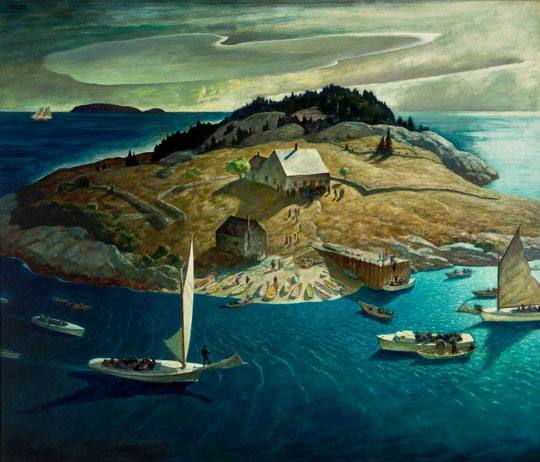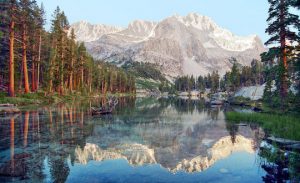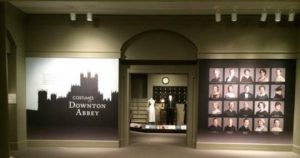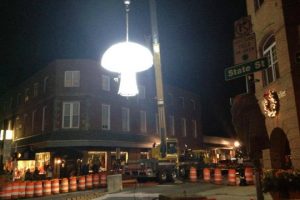When most people in the area think about art in Chadds Ford, the name Wyeth is sure to come to mind. Most people would think of Andrew Wyeth since he grew up in Chadds Ford and many people here today knew him personally. Other people would think of his son Jamie.

But the progenitor, the founding father of the famous art family was Newell Convers (N.C.) Wyeth. He also had a daughter, Henriette, an artist in her own right, who married artist Peter Hurd.
The Brandywine River Museum of Art has opened a new exhibit of N.C.’s work, N.C. Wyeth: New Perspectives. It runs through Sept. 15.
The exhibit is co-curated by Christine Podmaniczky from the BRM and Jessica May from the Portland Museum of Art and spans N.C.’s career as an illustrator in 1902 through his work as a muralist in the 1930s, his time in Port Clyde, Maine and into his last years in the 1940s.

N.C. Wyeth was from Needham, Mass., but came to the Brandywine Valley to study illustration with Howard Pyle in Chadds Ford. The school was in Turner’s Mill, the current Chadds Ford Township municipal building. His earliest sale was an illustration of a bronco rider — Bucking Bronco— which he personally sold to The Saturday Evening Post in 1903. It became his first magazine cover.
He maintained a western theme in those early days and both Podmaniczky and May noted during a press review that he had an understanding of marketing. That is reflected in his 1906 piece — Bronco Buster— which also shows a bronco rider but this time there’s a billboard for Cream of Wheat cereal in the background. An early version of what is now called product placement.
According to May, though, his western themes only lasted a few years. From there, he branched out to doing book illustrations and became noted for his artwork on “Treasure Island” and “Last of the Mohicans.”
He grew famous as an illustrator and was able to build a home in his adopted Chadds Ford. He worked quickly and, at one point, painted 17 pieces in a four-month period for the Treasure Island series. Yet, as Mary Cronin told an audience at the Chadds Ford Elementary School in March, he feared he would never be known as a serious painter. So he branched out from illustrations and became known as that serious painter.

Yet there was another side to N.C. Wyeth, one that’s rarely mentioned. May brought this up when discussing the mural Apotheosis of the Family that Wyeth did for a bank during the depression in 1931.
It’s a wide scene, pre-industrial what May referred to as “an Arcadian vision” or idealized rustic image of family. The pastoral landscape is untouched by modernity, “a moment of pre-industrial bliss,” she said, with man and nature as one.
“What’s so fascinating,” May said, “is that he’s locating this very pastoral image and these white Americans within this landscape out of a kind of ideal American place.
Yet, she added that it was at a time when Wyeth was learning about eugenics and that while he himself was not a racist, he was “a racialist,” someone who saw race and saw himself as part of a race.”
May also mentioned that it was during this time that Wyeth was writing to his mother about what he was reading about eugenics, the school of thought that says humans can be perfected through a process of controlled breeding. While not an overt racist, she said, he did have the racial biases of his age.
N.C. had bouts of depression in his later years, May said. Part of that was accepting the fact that his son Andrew would be a different type of painter. She said one of N.C,’s paintings, Nightfall, done in 1945, was done to compete with Andrew’s Pennsylvania Landscape, which the son had painted a few years earlier in 1941.
N.C. Wyeth was killed in 1945 when his car was struck by a train on Ring Road in Chadds Ford. A painting First Farmer of the Land was the piece he was working on when killed. It’s on display at the N.C. Wyeth Studio.
In all, 72 pieces are on display in two galleries, on the second and third floors of the museum.
If you go
Museum hours are 9:30 a.m. to 5 p.m. seven days per week but as of July 1, hours will be 9:30 a.m.-4:30 p.m.
Admission is $18 for adults, $15 for seniors and $6 for students with ID and for children 6-18.
The museum also offers tours of the N.C. and Andrew Wyeth studios and of the Kuerner Farm.

About Rich Schwartzman
Rich Schwartzman has been reporting on events in the greater Chadds Ford area since September 2001 when he became the founding editor of The Chadds Ford Post. In April 2009 he became managing editor of ChaddsFordLive. He is also an award-winning photographer.





Comments